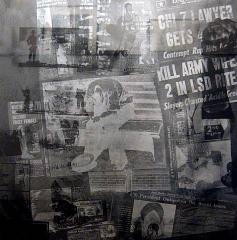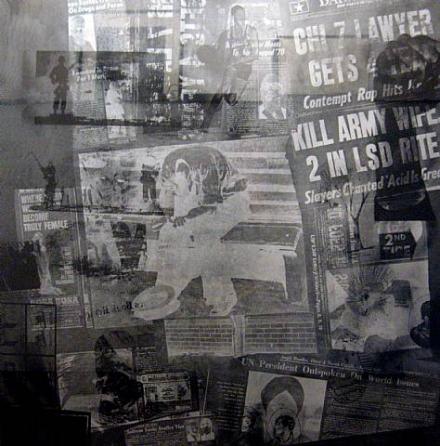 Rauschenberg
Rauschenberg
A personal appreciation on the occasion of Robert Rauschenberg's death
I was born in 1951, a clean slate, the same year Robert Rauschenberg accomplished his famous series of white interactive paintings. It seems to me he has been inter-filling my mind in ever since; though we never met.
I was trying to remember how I first became aware of his work: but of course it was through the mechanically reproduced. As a freshman at
Hinsdale High School I purchased a copy of Calvin Tomkins’s book "Ahead of the Game" (I still own it! – the cover incorporates "L.H.O.O.Q." by Marcel
Duchamp), in which Rauschenberg was introduced to me via Duchamp, John Cage and Jean Tinguely. I think I had been prepared to become devoted to his combination-permutation sensibility because I had been highly excited, as a 10 year old boy, by the Dada collages I had discovered in the Max Ernst exhibition I saw the summer of 1961 at the Art Institute of Chicago.

Rhizomatic Rauschenberg :
When I again cracked open "Ahead of the Game" now in thinking about
Rauschenberg’s death and his importance to my development as an artist, I
saw something I had carefully underlined using a straightedge back in
1965: Rauschenberg’s statement that "I consider myself successful only
when I do something that resembles the lack of order I sense". (p. 188)
I understand now that Ernst and Rauschenberg had presented to my young
mind remarkably complementary rhizomatic (*) networks of visual elements.
Their compositions were tight but lacked a quintessential sense of order
that provided me with a kind of aesthetic shatter; suggesting the nervous
sense of shocking unordered delirium I was experiencing with the
image/sound circulation system of television. The clearest example of that
I remember was my shock at seeing live Jack Ruby (Jacob Rubenstein)
fatally shoot the 24-year-old Lee Harvey Oswald on Sunday, November 24th, 1963 while authorities were preparing to transfer Oswald by car from
police headquarters to the nearby county jail. Popping out from the crowd
of reporters and photographers, Ruby fired a snub-nosed Colt Cobra .38
into Oswald's belly. (**)
Panic and chaos erupted in my peaceful suburban setting that Sunday
morning, searing into my 12year brain the perverse principle of jarring
juxtaposition. Was it here that I started to elucidate a radical semiurgy
full of conspiratorial concerns with the manipulative powers of cultural
images and information technologies? Was it then that art came to be for
me Rauschenbergian – that is, tied up with the image circulation system
itself – as ideas of shock culture became tied into Ernst's dada concept
of systematic displacement? Was this the first taste of the excess of the
technological information society that would push me towards technological chance operations and a commentarial political art hung up on persistent proliferation and the dissemination of signs? I do believe it probably was.
Early on then, throbbing at the hatch in the rear of my mind was
Rauschenberg with what constituted a new electronic wired world that
obliterated safe boundaries, categories and values of the previous
non-hyper industrial society while establishing new forms of social
organization and new forms of experiences. Are you experienced? Have you ever been experienced? Well I have.
Of course these are lyrics from Are You Experienced - the debut album by
The Jimi Hendrix Experience - which was released in 1967. I attended The
Jimi Hendrix Experience concert December 1, 1968 at the Chicago Coliseum and sat in the very last row – far far away from the stage. Hendrix
appeared miniscule, however the speakers were located just behind my head and the sound was earsplitting; an intensely pleasant, if disjunctive,
experience.
This is not precisely the same as Kurt Schwitters’s collage approach, a
technique that in large part comprised Rauschenberg’s overarching
methodology. This is not slapping diverse things together so much as
pulling typical things apart. But perhaps this is the explosion that
collage implosion implies.
Surely I have a great appreciation of Bob’s work with the Merce
Cunningham's dance company; work that perhaps best exemplifies his working in the gap between art and life. But then so did his performance pieces in the 1960s, such as "Pelican" (1963) and "Open Score" (1966) (which employed chance operations) and his founding of Change Inc., a charitable organization for impoverished artists.
In the mid-1970s I moved to New York City into the Tribeca area. I was
dating a dancer at the time who’s prior boyfriend worked for Rauschenberg
and one day we went to Rauschenberg’s studio on Lafayette for a visit, but
he was not in. Still he soon came to represent for me an exemplary artist,
one engaged in political concerns tied to technological means. He seemed
to me capable of harnessing both the forces of explosion and implosion
that manifested a new hyper-rhizomatic era in the making. This was an era
in which the new technologies of media distribution, virtual systems,
computer networks, and information processing began supplanting industrial production and the gold-based economy as the organizing
synthesis/principle of society.
The reductive minimalist aesthetic, so prevalent there at that time,
seemed inertly incapable of expressing this coming cybernetic situation,
whereas Rauschenberg's art - saturated with media messages – signaled to
me a malleable philosophical principle appropriate to the time. This
principle was exemplified by his habitual mixing of the mechanical and the
loose gesture; a game juxtaposition of the mechanically reproduced
photographic image and the poorly handcrafted, which I saw in slightly
dangerous terms.
I recall with no pleasure returning home from a huge retrospective of his
work at MOMA in 1977; numb and indifferent to the excessive glut I had
experienced. That sense of disillusionment forced me to negatively
confront Rauschenberg's over-all gesamt aesthetic, his embracing of all
materials and all of life within a facile collage encounter which
downplayed grandiloquent reason. I had a similar experience at the
Guggenheim Museum’s Rauschenberg retrospective in 1997. However individual works continued to capture my attention as I took a greater interest in ideas of excess and ecstatic encounters. Most importantly in the mid-1980s I obtained one of Rauschenberg’s black and white silkscreens from his Current and Surface Series (1970). Living with this work, I discovered the best of Rauschenberg’s work I think - work which contains rhizomatic layered image sequences where the viewer interprets the progression of images as though reading a ruined communication system arranged in multiple, simultaneous combinations. Rauschenberg here dissolves away the paradigmatic model of media as communications and replaces it with one of failed pageant that leads to both a collapse of meaning and the destruction of distinctions between media and myth. In Rauschenberg’s media mythic society, I saw through the numerous saturating media messages, so that information and meaning imploded into pure effect, without content or meaning. In fact here content becomes decorative and ornate.
This rhizomatic Rauschenberg demands a different kind of looking - akin to the aggregated viewpoints of Cubism compared by John Cage to watching "many television sets working simultaneously all tuned in differently".
(***) In my piece from his Current and Surface Series there is no obvious
hierarchy of images to scan. The trajectory of visual exploration for it
is of our own choosing - a dysfunctional situation which no longer
communicates purposeful messages but rather proposes pattern. Here we have a rhizomatic visual pleasure, where everything equally connects to
everything else, and so replaces visual purpose. This is an art that
demands of society an active visualizing participation in private
interpretations - and thus is a legitimate metaphor for contemporary art
as a form of simulation-shattering engagement. It functions by overloading
representation to a point where it becomes non-representational.
Concerning Bob’s instantaneous non-separability and ubiquity, of course I
cannot fail to mention a counter example - my great appreciation of
Rauschenberg’s graceful Erased de Kooning. Nor may we forget his combining art and new technology (combined with the pursuit of inexactitude) in the famous "9 Evenings: Theatre and Engineering" of 1966 that he helped organize with the engineer Billy Kluver.
Rauschenberg understood that through the mediation of machines, the technological built-in can be contorted and bent, thus changing our awareness of what technology is. So I will argue here that Rauschenberg’s art is indispensable to us even today by demonstrating how an art of rhizomatic visual pleasure – when produced by the milieu of image superabundance and information proliferation - is an art that can problematize technology and hence enliven us to the privateness - and unique separateness - of the human condition in lieu of the fabulously constructed social spectacle which engulfs and (supposedly) controls us. This private separateness offers us a personal critical distance (a bacchanalia gap), and thus another perspective on (and from) the given social simulacra.
Notes:
(*) A rhizome is a horizontal, root-like stem that extends underground and
sends out shoots to the surface. Rhizomes connect plants in a living
network. Rhizome is also a figurative term used by Gilles Deleuze and
Felix Guattari to describe non-hierarchical networks of all kinds. Here
are a few quotations from their seminal book, A Thousand Plateaus.
"A rhizome as subterranean stem is absolutely different from roots and
radicles. Bulbs and tubers are rhizomes. Plants with roots or radicles may
be rhizomorphic in other respects altogether: the question is whether
plant life in its specificity is not entirely rhizomatic. Even some
animals are, in their pack form. Rats are rhizomes... The rhizome itself
assumes very diverse forms, from ramified surface extension in all
directions to concretion into bulbs and tubers... We get the distinct
feeling that we will convince no one unless we enumerate certain
approximate characteristics of the rhizome." -p. 7
"A rhizome ceaselessly establishes connections between semiotic chains,
organization of power, and circumstances relative to the arts, sciences,
and social struggles." -p.7
"Multiplicities are rhizomatic, and expose arborescent
pseudomultiplicities for what they are." -p. 8
"Write, form a rhizome, increase your territory by deterritorialization,
extend the line of flight to the point where it becomes an abstract
machine covering the entire plane of consistency." -p. 11
"We're tired of trees." -p. 15
"To these centered systems [arborescent structures], the authors contrast
a-centered systems, finite networks of automata in which communication
runs from any neighbor to another, the stems or channels do not preexist,
and all individuals are interchangeable, defined only by their state at a
given moment -- such that the local operations are coordinated and the
final, global result synchronized without a central agency." -p. 17
"Let us summarize the principal characteristics of a rhizome: unlike trees
or their roots, the rhizome connects any point to any other point, and its
traits are not necessarily linked to traits of the same nature; it brings
into play very different regimes of signs, and even nonsign states. The
rhizome is reducible neither to the One nor the multiple... It is composed
not of units but of dimensions, or rather directions in motion." -p. 21
[The quotations above are from A Thousand Plateaus: Capitalism and
Schizophrenia by Gilles Deleuze and Felix Guattari. Translated by Brian
Massumi. University of Minnesota Press, Minneapolis. 1987.]
(**) This video clip is viewable now on YouTube at:
http://www.youtube.com/watch?v=7rp3sX3A48g
(***) John Cage, ‘On Robert Rauschenberg, artist, and his work’ (first
published in Metro, Milan, 1961); republished in Silence 4th edition,
M.I.T Press, Cambridge, Massachusetts, 1970, p. 13
change inc.
i remember back in the early 90ies, when the thing had one of its many fiscal crises, change inc. came to the rescue and sent a $500 check, signed by rauschenberg personally, to cover back rent and utilities.
it was a quick and totally unbureaucratic affair, a huge contrast to what you have to go through today when trying to raise money for a small non-profit organization. so i raise the glass of vodka tonic before me to you... thanks bob!